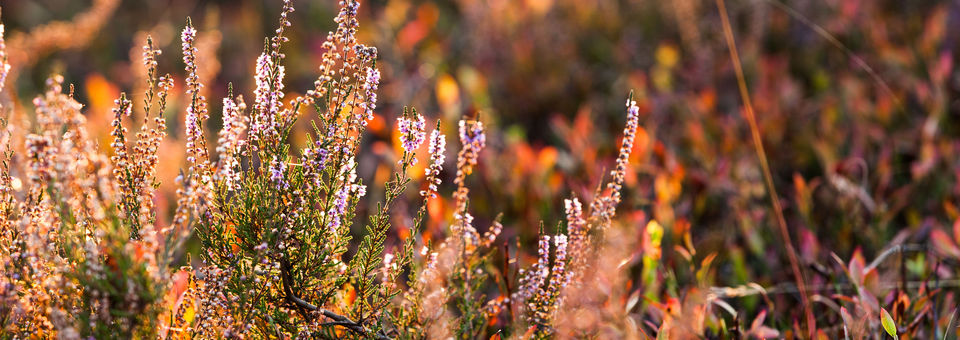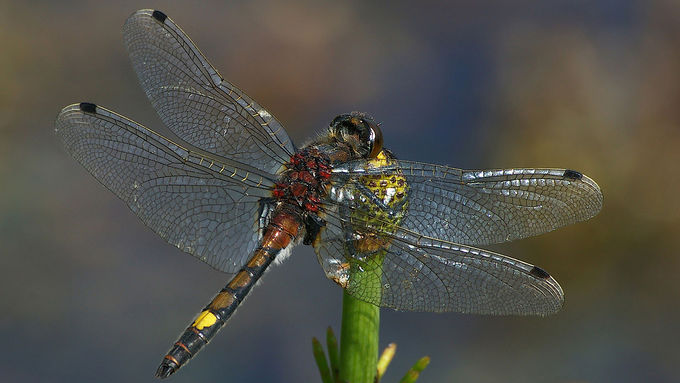Große Moosjungfer/Yellow-spotted Whiteface (Leucorrhinia pectoralis) © Christian Fischer (https://commons.wikimedia.org/wiki/File:LeucorrhiniaPectoralisMale2.jpg), „LeucorrhiniaPectoralisMale2“, https://creativecommons.org/licenses/by-sa/3.0/legalcode
download picturemain content
Protected Species
Leucorrhinia pectoralis (1042)
Yellow-spotted Whiteface
The Yellow-spotted Whiteface is a predominantly dark coloured skimmer which is up to four centimetres long and has a wingspan of six to seven centimetres. This makes it the largest member of its genus in Europe. The white forehead is typical of the genus. Another external characteristic of adult males is a bright yellow spot on the seventh abdominal segment and reddish brown spots on the abdominal segments one to six. Females which look a little bit sturdier and young males, on the other hand, have large yellow spots on the abdomen segments one to seven.
Habitat and biology
The Yellow-spotted Whiteface is found in boundary areas of moors, transition bogs, and forest moors. For reproduction, moderately acidic waters low in nutrients to moderately nutrient-rich waters with pondweed and water lilies are used as well as extensively used peat-cutting sites. Medium succession stages are optimal for use. Pioneer waters, densely overgrown waters or waters that have already been silted are avoided.
The peak times of the adult animals ranges from mid-May until the end of July. Shallow water areas with a dark underground which heat up quickly in sunlight are preferred for oviposition. During the larval development which lasts two to three years the larvae stay within the reed zone. The larvae leave the waters from the end of April until the beginning of June to shed their skins and turn into flying dragonflies.
Occurrence
In North Rhine-Westphalia, the Yellow-spotted Whiteface is classified as „critically endangered“ (CR). In 2012, there were also increased individual verifications away from colonised reproduction waters. The main areas of distribution are clearly within the lowlands of the Atlantic region.
The species is still widely distributed in Lower Saxony, but not frequent. The species is classified as “Endangered” (EN) in the Red List of Lower Saxony. The main areas of distribution are also in the lowlands.
Threats
The primary threats for the species are:
- loss or degradation of habitat (in particular backfilling, reforestation, construction),
- change of the water balance in moor areas (in particular drawdown of water table),
- deterioration of the water quality due to nutrients and contaminants.
Other restrictions for this species include:
- succession of the habitat (in particular weedage, aggradation),
- shading of the water by ligneous vegetation,
- removal of water and bank vegetation and structural elements in the water,
- fish stock and intensification of the fish farming.
Types of action
Basic implementation actions for the protection and the improvement of the conservation status are given by maintenance and development of natural mesotrophic moor border waters, heath water, turf cutting with abundant aquatic vegetation and natural weak eutrophic water with reed vegetation. Ditches in the appropriate development stages today also play a major role as secondary habitats relatively frequently populated by the Yellow-spotted Whiteface. For the areas around the waterbodies, structured vegetation with moor and heath vegetation, reeds, scrub and small shrubs should be targeted as well as open spaces maintained and developed.
Improvement actions for the water balance should also be met. This can be achieved in the surroundings of the waterbodies by reducing nutrients and contaminants by creating buffer zones or targeted extensification. In populated waters, there should also be no fish stock, or, if applicable, the long-term removal of fish should be supported.
Actions within phase 1 of the LIFE IP
In the first phase of the project, three actions will be implemented in North Rhine-Westphalia aimed at improving the conservation status of the Yellow-spotted Whiteface. This involves the optimisation of a pond or the creation of new heath ponds as well as the optimisation of the respective surrounding areas. The actions are directly connected to the improvement of the conservation status of the respective habitat types (3130, 4010, and 7140).
Related Topics
additional information
Further Links
- Species profile „Yellow-spotted Whiteface“ – State Agency for Nature, Environment and Consumer Protection (LANUV NRW) (in German) (external link opens in a new window)
- Implementation notes for the protection of the Yellow-spotted Whiteface – Lower Saxony Water Management, Coastal Defence and Nature Conservation Agency (NLWKN) (in German) (external link opens in a new window)
- Species profile „Yellow-spotted Whiteface“ – German Federal Agency for Nature Conservation (BfN) (in German) (external link opens in a new window)
- German Prioritised Action Frameworks (PAF): Yellow-spotted Whiteface, page 145 – German Federal Agency for Nature Conservation (BfN) (in German) (external link opens in a new window)




